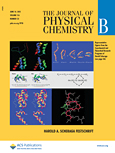
JOURNAL OF PHYSICAL CHEMISTRY B
Scope & Guideline
Advancing the Frontiers of Physical Chemistry
Introduction
Aims and Scopes
- Molecular Dynamics Simulations:
The journal frequently publishes studies utilizing molecular dynamics simulations to investigate the behavior of various molecular systems, including proteins, lipids, and polymers, under different conditions. - Spectroscopic Techniques:
Research involving advanced spectroscopic methods such as NMR, IR, and fluorescence spectroscopy is a prominent theme, aiding in the understanding of molecular interactions and dynamics. - Electrochemistry and Ionic Liquids:
The journal has a strong focus on the electrochemical properties of ionic liquids and their applications, exploring their interactions with biomolecules and their role in energy storage. - Nanotechnology and Materials Science:
Research on nanostructured materials and their interactions at the molecular level, particularly in the context of drug delivery and environmental applications, is a significant area of interest. - Biophysical Chemistry:
The intersection of physical chemistry and biology is highlighted through studies on protein folding, aggregation, and enzyme dynamics, which further the understanding of biochemical processes. - Machine Learning Applications:
The integration of machine learning techniques into molecular modeling and simulations is a growing trend, providing new insights into complex chemical systems.
Trending and Emerging
- Interfacial Phenomena:
Research on the dynamics and properties of interfaces, particularly in the context of nanotechnology and biomolecular interactions, has gained traction, highlighting the importance of surface effects in various applications. - Machine Learning in Chemistry:
The application of machine learning techniques to predict molecular properties, optimize reactions, and analyze complex data sets is rapidly emerging as a key theme, showcasing the journal's commitment to innovative methodologies. - Sustainable and Green Chemistry:
Studies focusing on environmentally friendly materials, including ionic liquids and biodegradable polymers, are on the rise, reflecting a growing emphasis on sustainability in chemical research. - Biomolecular Dynamics:
There is an increasing interest in the dynamics of biomolecules, including proteins and nucleic acids, particularly in understanding their folding, aggregation, and interactions with cellular environments. - Thermodynamics and Kinetics of Complex Systems:
Research exploring the thermodynamic and kinetic aspects of complex molecular systems, particularly in the context of phase transitions and self-assembly processes, is gaining prominence.
Declining or Waning
- Traditional Organic Chemistry:
There is a noticeable decline in the publication of papers focused solely on traditional organic chemistry topics, as the journal increasingly emphasizes physical chemistry and interdisciplinary approaches. - Theoretical Studies without Experimental Validation:
Papers presenting theoretical models without accompanying experimental data have become less common, indicating a preference for studies that integrate both approaches. - Static Structural Studies:
Research focusing purely on static structures, without considering dynamic aspects or interactions, is waning, as the field moves towards understanding the dynamics of molecular systems. - Low-Impact Studies:
The journal seems to be publishing fewer studies that do not provide significant new insights or advancements in understanding molecular behavior, reflecting a trend towards higher-impact research.
Similar Journals
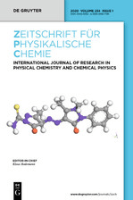
ZEITSCHRIFT FUR PHYSIKALISCHE CHEMIE-INTERNATIONAL JOURNAL OF RESEARCH IN PHYSICAL CHEMISTRY & CHEMICAL PHYSICS
Fostering Excellence in Chemical ResearchZEITSCHRIFT FUR PHYSIKALISCHE CHEMIE-INTERNATIONAL JOURNAL OF RESEARCH IN PHYSICAL CHEMISTRY & CHEMICAL PHYSICS, published by WALTER DE GRUYTER GMBH, is a highly regarded platform for researchers in the field of physical chemistry and chemical physics. With an ISSN of 0942-9352 and an E-ISSN of 2196-7156, this journal serves as a vital resource for the dissemination of original research, critical reviews, and insightful discussions that span theoretical and experimental investigations. Recognized for its quality, it holds a Q2 classification within the 2023 quartiles of Physical and Theoretical Chemistry and ranks 72nd out of 189 in the Scopus database, placing it in the 62nd percentile. The journal’s extensive publication history, originating from 1943, showcases its long-standing commitment to advancing the understanding of complex chemical phenomena. Although it currently does not offer open-access options, it continues to attract contributions from leading experts worldwide, making it essential reading for professionals, researchers, and students dedicated to pushing the frontiers of chemical science. The journal is located in Berlin, Germany, at Genthiner Strasse 13, D-10785 Berlin, Germany.

Molbank
Exploring the Frontiers of Biochemistry and BeyondMolbank is an open-access journal published by MDPI, dedicated to the fields of Biochemistry, Organic Chemistry, and Physical and Theoretical Chemistry. Established in 2002, this journal has served as a vital platform for the dissemination of research findings, where researchers and professionals share original articles focusing on molecular chemistry, synthesis, and related studies. With a commitment to open access, Molbank enables global access to scientific knowledge, fostering collaboration and innovation among scientists. While currently categorized in the fourth quartile for its field rankings, it provides a unique opportunity for emerging scholars to contribute to and engage with the scientific community. The journal is based in Switzerland, operating from its office at ST ALBAN-ANLAGE 66, CH-4052 BASEL, SWITZERLAND, and continues to attract submissions until 2024. Researchers, students, and professionals looking to expand their knowledge and participate in the dialogue of current molecular chemistry can benefit significantly from engaging with the content published in Molbank.

Journal of Physical Chemistry Letters
Bridging Disciplines, Transforming KnowledgeThe Journal of Physical Chemistry Letters, published by the American Chemical Society, is a premier journal in the fields of Physical and Theoretical Chemistry, Materials Science, and Nanoscience and Nanotechnology. Since its inception in 2010, this journal has established itself as a significant platform for rapid publications of cutting-edge research that bridges various branches of chemistry, providing a critical avenue for advancing knowledge in these dynamic fields. With an impressive impact factor and a consistent ranking in the top quartile (Q1) of its categories, the journal ranks 25th out of 189 in Physical and Theoretical Chemistry and 79th out of 463 in General Materials Science according to Scopus metrics. Although it currently does not operate under an open access model, it remains an essential resource for academics seeking to disseminate their findings to a global audience. Researchers, professionals, and students alike will find invaluable insights and contributions that push the boundaries of scientific inquiry within these disciplines.

BIOPHYSICAL CHEMISTRY
Connecting disciplines to illuminate the science of life.BIOPHYSICAL CHEMISTRY, published by Elsevier, is a prestigious journal with a long-standing tradition since its inception in 1973. This highly respected journal focuses on the intersections of biochemistry, biophysics, and organic chemistry, providing a critical platform for researchers, professionals, and students to disseminate pivotal findings in these dynamic fields. With an impressive impact factor that reflects its robust academic influence and high citation rates, it ranks within the Q2 quartile among its peers in multiple categories, indicating its significance in the scholarly community. The journal, hosted in the Netherlands, encompasses a diverse range of topics, from molecular interactions to protein folding, and serves as an essential resource for those engaged in cutting-edge research. Researchers looking to share their work with a global audience will find BIOPHYSICAL CHEMISTRY an invaluable outlet, fostering the advancement of knowledge in this crucial area of science. For more information, visit the journal's page on the Elsevier platform.
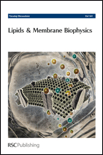
FARADAY DISCUSSIONS
Advancing Knowledge Through Scholarly DialogueFARADAY DISCUSSIONS, published by the prestigious Royal Society of Chemistry, serves as a premier platform for scholarly discourse in the realms of both Physical and Theoretical Chemistry and Medicine. With its ISSN 1359-6640 and E-ISSN 1364-5498, this journal has a rich history dating back to 1947, evolving through significant periods of scientific advancement, with engaging discussions scheduled through to 2024. Recognized for its impact, FARADAY DISCUSSIONS ranks in the Q1 category for Physical and Theoretical Chemistry and Q2 for miscellaneous Medicine in 2023, affirming its role in pioneering research and innovative thought leadership. Researchers and professionals alike benefit from this journal’s commitment to open, critical dialogue on current trends and breakthroughs in chemistry, making it an essential resource for anyone looking to stay at the forefront of these dynamic fields.
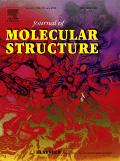
Journal of Molecular Structure
Exploring the intricate dance of molecular structures.Journal of Molecular Structure is a premier publication in the field of chemistry, offering a platform for innovative research that spans analytical, inorganic, organic chemistry, and spectroscopy. Published by Elsevier in the Netherlands, this journal is committed to advancing the understanding of molecular architecture and behavior through high-quality, peer-reviewed articles. With its impressive impact factor and a notable Scopus ranking placing it in the top quartiles among its peers, it serves as an essential resource for researchers, professionals, and students alike. The journal's open access options promote the dissemination of knowledge, ensuring that groundbreaking discoveries reach a broad audience. Established in 1967 and projected to continue through 2025, the Journal of Molecular Structure is vital for anyone engaged in the study of molecular interactions and structural analysis.
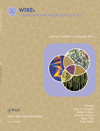
Wiley Interdisciplinary Reviews-Computational Molecular Science
Connecting Computational Methods with Molecular BreakthroughsWiley Interdisciplinary Reviews: Computational Molecular Science is a premier journal published by WILEY, dedicated to the intersection of computational techniques and molecular science. Boasting an impressive impact factor and consistently ranking in the Q1 category across several key disciplines including Biochemistry, Computational Mathematics, Computer Science Applications, Materials Chemistry, and Physical and Theoretical Chemistry, this journal plays a crucial role in disseminating high-quality research that bridges multiple fields. With its focus on providing a platform for interdisciplinary dialogue and innovative computational solutions, it serves as an essential resource for researchers, professionals, and students eager to push the boundaries of molecular science. While the journal does not currently offer open access, it remains a vital conduit for scholarly communication, fostering advancements in understanding molecular interactions through computational methods. The journal is based in the United States, contributing to its global outreach and impact in the scientific community.
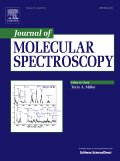
JOURNAL OF MOLECULAR SPECTROSCOPY
Unveiling Molecular Mysteries Through Rigorous ResearchJOURNAL OF MOLECULAR SPECTROSCOPY, published by Academic Press Inc Elsevier Science, serves as a pivotal platform in the fields of Atomic and Molecular Physics, Physical and Theoretical Chemistry, and Spectroscopy. With its inaugural issue dating back to 1957, this journal has maintained a rich history of disseminating significant research findings, contributing to an understanding of molecular behavior and interactions through various spectroscopic techniques. Although currently positioned in the Q3 quartile across its respective categories as per 2023 rankings, the journal aims to enhance its stature further by promoting rigorous and impactful studies that push the boundaries of knowledge in spectroscopy. While access to this publication is not open, the rigorous peer-review process ensures that the articles published maintain high standards of scientific excellence, appealing to researchers, professionals, and students seeking comprehensive insights into molecular spectroscopy. The journal's ISSN is 0022-2852 and its E-ISSN is 1096-083X.
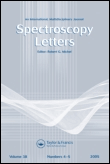
SPECTROSCOPY LETTERS
Illuminating the Frontiers of SpectroscopySPECTROSCOPY LETTERS, published by Taylor & Francis Inc, is a pivotal journal that plays a significant role in the fields of Analytical Chemistry, Atomic and Molecular Physics, and Optics. With an ISSN of 0038-7010 and E-ISSN of 1532-2289, it provides a platform for the dissemination of cutting-edge research and developments in spectroscopy and its wide-ranging applications. As of 2023, the journal is ranked in the third quartile (Q3) across its relevant categories, reflecting its importance in these scientific domains. The journal has a continuous publication history from 1968 to 2024, establishing a rich legacy in academic literature. Although it currently does not offer Open Access options, SPECTROSCOPY LETTERS remains a valuable resource for researchers, professionals, and students seeking to advance their knowledge and applications in spectroscopy. For those in the arena of physics and chemistry, this journal is essential for keeping abreast of the latest findings and methodologies in the field.

INTERNATIONAL REVIEWS IN PHYSICAL CHEMISTRY
Connecting Researchers with Groundbreaking DiscoveriesInternational Reviews in Physical Chemistry, published by Taylor & Francis Ltd, is a leading journal dedicated to the advancement of knowledge in the field of physical and theoretical chemistry. With an impressive Scopus Rank of 13 out of 189 in its category and a Q2 quartile ranking in 2023, this journal provides a vital platform for researchers, professionals, and students to disseminate and engage with groundbreaking research findings. Since its inception, covering a converged period from 1981 to 2023, the journal has consistently offered comprehensive reviews and original research articles that address crucial advances and contemporary debates in physical chemistry. While not an open-access journal, it maintains accessibility through its robust publication standards and esteemed editorial board. Given its impact and relevance, International Reviews in Physical Chemistry is indispensable for anyone involved in the chemical sciences, facilitating a deeper understanding of complex physical principles and their applications.